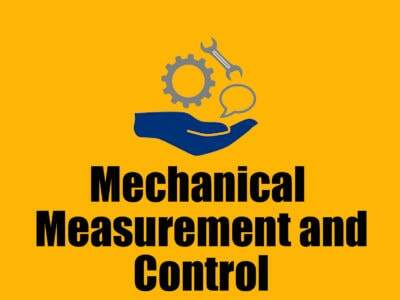Mechanical Measurement and Control
Free

Mechanical Measurement and Control
Objectives of studying the subject Mechanical Measurement and Control is to impart knowledge of architecture of the measurement system. To deliver working principle of mechanical measurement system.
To study concept of mathematical modelling of the control system. To acquaint with control system under different time domain Outcomes for the subject Mechanical Measurement and Control Learner will be able to… Classify various types of static characteristics and types of errors occurring in the system. Classify and select proper measuring instrument for linear and angular displacement. Classify and select proper measuring instrument for pressure and temperature measurement. Design mathematical model of system/process for standard input responses. Analyse error and differentiate various types of control systems and time domain specifications. Analyse the problems associated with stability. Chapter Significance of Mechanical Measurements, Classification of measuring instruments, generalized measurement system, types of inputs: Desired, interfering and modifying inputs. Chapter Static characteristics: Static calibration, Linearity, Static Sensitivity, Accuracy, Static error, Precision, Reproducibility, Threshold, Resolution, Hysteresis, Drift, Span & Range etc. Chapter Errors in measurement: Types of errors, Effect of component errors, Probable errors.
Tachometer generators (or tachogenerators) are electromechanical devices which output a voltage proportional to their shaft speed. They are used to power tachometers and to measure the speed of motors, engines, and other rotational devices. The nozzle and flapper mechanism is a displacement type detector which converts mechanical movement into a pressure signal, by covering the opening of a nozzle with a flat plate called the flapper.This restricts fluid flow through the nozzle and generates a pressure signal. It is a widely used mechanical means of creating a high gain fluid amplifier. In industrial control systems they played an important part in the development of pneumatic PID controllers and are still widely used today in pneumatic and hydraulic control and instrumentation systems.
Chapter Displacement Measurement consists of the following subtopics Transducers for displacement, displacement measurement, potentiometer, LVDT, Capacitance Types, Digital Transducers (optical encoder) , Nozzle Flapper Transducer. Chapter Strain Measurement consists of the following subtopics Theory of Strain Gauges, gauge factor, temperature Compensation, Bridge circuit, orientation of strain gauges for force and torque, Strain gauge based load cells and torque sensors. Chapter Measurement of Angular Velocity: Tachometers, Tachogenerators, Digital tachometers and Stroboscopic Methods. Chapter Acceleration Measurement consists of the following subtopics theory of accelerometer and vibrometers, practical accelerometers, strain gauge based and piezoelectric accelerometers.
Chapter Pressure Measurement consists of the following subtopics Elastic pressure transducers viz. Bourdon tubes, diaphragm, bellows and piezoelectric pressure sensors, High Pressure Measurements, Bridge man gauge. Vacuum measurement: Vacuum gauges viz. McLeod gauge, Ionization and Thermal Conductivity gauges. Chapter Flow Measurement consists of the following subtopics Bernoulli flowmeters, Ultrasonic Flowmeter, Magnetic flow meter, rotameter. Temperature Measurement consists of the following subtopics Electrical methods of temperature measurement Resistance thermometers, Thermistors and thermocouples, Pyrometers. Chapter Sensitivity analysis of sensor-influence of component variation. Chapter Signal conditioning: Amplifier, Conversion, Filtering, Impedance Buffering, Modulation / Demodulation, Linearization, Grounding and Isolation.
Chapter Introduction to control systems, Classification of control system. Open loop and closed loop systems. Mathematical modelling of control systems, concept of transfer function, Block diagram algebra. Transient and steady state analysis of first and second order system. Time Domain specifications. Step response of second order system. Steady-state error, error coefficients, steady state analysis of different type of systems using step, ramp and parabolic inputs. Stability analysis consists of the following subtopics Introduction to concepts of stability, The Routh criteria for stability. Experimental determination of frequency response, Stability analysis using Root locus, Bode plot and Nyquist Plots 6.3 State space modeling 6.4 Process control systems, ON-OFF control. P-I-D Control.
Suggested References books for the subject Mechanical Measurement and Control by Mumbai University are as follows Measurement Systems: Applications and Design, by EO Doebelin, 5 th Edition,McGraw Hill Mechanical Engineering Measurements, A K Sawhney, Dhanpat Rai& Sons, New Delhi. Instrumentation & Mechanical Measurements, A K Thayal. Control System Engineering by Nagrath IJ and Gopal M, Wiley Eastern Ltd. Modem Control engineering: by KOgata, Prentice Hall 6. Control systems by DhaneshManik, Cengage Learning. Engineering Metrology and Measurementsby N V Raghavendra and L Krishnamurthy, Oxford University Press. Instrumentation and Control System, W. Bolton, Elsevier. Experimental Methods for Engineers by J P Holman, McGraw Hills Int. Edition. Engineering Experimentation by EO Doebelin, McGraw Hills Int. Edition. Mechanical Measurements by S P Venkateshan, Ane books, India.
Prepare For Your Placements: https://lastmomenttuitions.com/courses/placement-preparation/
![]()
/ Youtube Channel: https://www.youtube.com/channel/UCGFNZxMqKLsqWERX_N2f08Q
Follow For Latest Updates, Study Tips & More Content!
Course Features
- Lectures 13
- Quizzes 0
- Duration 50 hours
- Skill level All levels
- Language English
- Students 183
- Certificate No
- Assessments Yes


![VIVA QUESTION Wipro Elite /WILP Complete Prep Courses [ Videos + Notes + Mock ]](https://lastmomenttuitions.com/wp-content/uploads/2019/08/VIVA-QUESTION-450x450.png)
![WhatsApp Image 2020-06-26 at 12.15.44 PM First Year Sem 2 MU NEP [ Comps – IT – AIML Branch ]](https://lastmomenttuitions.com/wp-content/uploads/2020/02/WhatsApp-Image-2020-06-26-at-12.15.44-PM.jpeg)
![demo_image Sem-4 IT MU [ Maths 4 – CNN – OS – AT – COA ]](https://lastmomenttuitions.com/wp-content/uploads/2019/07/demo_image-450x450.jpg)